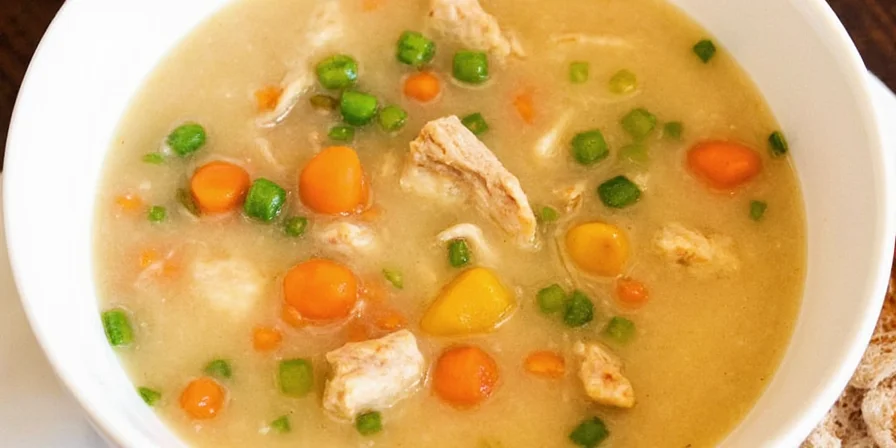What spices should you put in chicken soup for the best flavor? The top spices for classic chicken soup are black pepper, thyme, bay leaves, parsley, and garlic. These create balanced flavor without overpowering the delicate chicken broth. Add whole peppercorns early in cooking, dried herbs like thyme at mid-simmer, and fresh parsley in the last 5 minutes for optimal results.
Unlike complicated "scientific" approaches, this guide shares practical spice combinations that home cooks actually use. You'll learn exactly which spices work best for chicken soup, when to add them, and simple techniques that make a real difference in flavor. No biochemistry degree required—just clear, tested advice that works in real kitchens.
Table of Contents
- Why Spice Selection Matters for Chicken Soup
- Top 5 Essential Spices for Chicken Soup
- Simple Timing Techniques That Work
- Practical Flavor Boosters
- Common Spice Mistakes to Avoid
- Best Spice Combinations
- Frequently Asked Questions
- Final Tips for Perfectly Seasoned Soup
Why Spice Selection Matters for Chicken Soup
Chicken soup's comforting flavor depends on the right spice balance. Too little seasoning makes bland soup, while too much creates overwhelming flavors. The best approach combines:
- Layering flavors: Adding spices at different cooking stages creates depth
- Complementary pairings: Certain spices naturally enhance each other's flavors
- Balanced intensity: Using the right amount of each spice so none dominates
Professional chefs and home cooks agree: proper spice timing and combinations make the biggest difference in soup flavor, often more than the quality of ingredients.
Top 5 Essential Spices for Chicken Soup
These spices consistently deliver the best flavor in homemade chicken soup:
- Black Pepper: Adds warmth without heat. Use 5-6 whole peppercorns per pot early in cooking. Whole peppercorns provide better flavor than pre-ground pepper.
- Bay Leaves: Creates subtle background notes. Add 1-2 leaves during simmering and remove before serving. Don't skip this simple ingredient—it makes a noticeable difference.
- Thyme: The classic herb for chicken soup. 1 teaspoon dried thyme (or 3 sprigs fresh) added mid-simmer creates perfect herbal notes without overpowering.
- Parsley: Adds fresh brightness. Stir in 2 tablespoons chopped fresh parsley during the last 5 minutes of cooking.
- Garlic: Provides savory depth. 2-3 minced cloves added when sautéing vegetables creates foundational flavor.

Simple Timing Techniques That Work
When you add spices matters more than most home cooks realize:
- Start of cooking: Whole spices like peppercorns and bay leaves. These need time to release flavor.
- Middle of cooking: Dried herbs like thyme and oregano. Add when soup is actively simmering.
- Last 5-10 minutes: Fresh herbs like parsley and dill. Adding too early makes them lose flavor.
- Before serving: A squeeze of fresh lemon juice or dash of salt to brighten flavors.
Practical Flavor Boosters
These simple techniques improve soup flavor without complicated science:
- Toasted spices: Lightly toast whole peppercorns in a dry pan for 1 minute before adding to soup for deeper flavor.
- Fresh garlic trick: Let minced garlic sit for 10 minutes before cooking to develop more flavor compounds.
- Salt timing: Add 75% of salt at beginning, 25% at end for better flavor distribution.
- Lemon finish: A small squeeze of fresh lemon juice right before serving brightens all flavors.
- Herb sachet: Tie herbs in cheesecloth for easy removal and controlled flavor release.
Common Spice Mistakes to Avoid
Avoid these frequent errors that ruin good chicken soup:
- Adding all spices at once: Different spices need different cooking times for best results.
- Using old spices: Dried herbs lose potency after 6 months. Test by smelling—if weak, replace.
- Over-simmering fresh herbs: They become bitter if cooked too long. Add in last few minutes.
- Skipping bay leaves: They add subtle complexity many cooks miss when omitted.
- Using pre-ground pepper: Whole peppercorns provide fresher, more complex flavor.
Best Spice Combinations
| Spice Combination | When to Use | Ratio | Why It Works |
|---|---|---|---|
| Pepper + Bay Leaves + Thyme | Classic chicken soup | 6 peppercorns : 2 bay leaves : 1 tsp thyme | Creates balanced herbal notes with subtle warmth |
| Parsley + Dill + Lemon | Light, fresh chicken soup | 2 tbsp parsley : 1 tbsp dill : 1 lemon wedge | Adds brightness without overpowering chicken flavor |
| Garlic + Rosemary + Black Pepper | Hearty winter chicken soup | 3 garlic cloves : 1 sprig rosemary : 6 peppercorns | Creates robust, warming flavor profile |
| Thyme + Oregano + Bay Leaf | Mediterranean-style chicken soup | 1 tsp thyme : 1/2 tsp oregano : 2 bay leaves | Provides earthy, aromatic base for vegetable-heavy soups |

Frequently Asked Questions
Final Tips for Perfectly Seasoned Soup
Creating great chicken soup doesn't require complicated techniques—just thoughtful spice use. Remember these key points:
- Use whole peppercorns instead of pre-ground pepper for better flavor
- Never skip bay leaves—they add subtle complexity you'll miss if omitted
- Add dried herbs mid-simmer and fresh herbs at the very end
- Finish with a small squeeze of lemon juice to brighten all flavors
- Taste and adjust seasoning at the end—you can always add more but can't remove excess
With these practical techniques, you'll consistently make chicken soup with perfectly balanced, comforting flavors. No special equipment or scientific knowledge needed—just these simple spice strategies that home cooks have used for generations.
Try these spice techniques in your next batch of chicken soup and notice the difference. What's your favorite spice combination for chicken soup? Share your go-to recipe in the comments.











 浙公网安备
33010002000092号
浙公网安备
33010002000092号 浙B2-20120091-4
浙B2-20120091-4